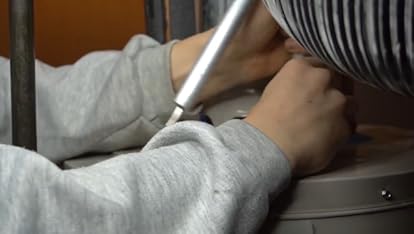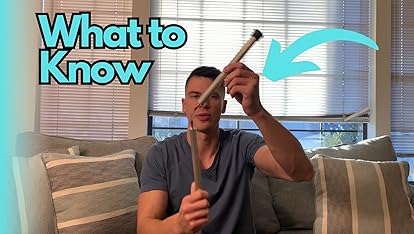| Item Weight | 1 Pounds |
|---|---|
| Manufacturer | Rheem |
| Part Number | AP12938 |
| Item Weight | 1 pounds |
| Product Dimensions | 0.63 x 0.63 x 42 inches |
| Item model number | AP12938 |
| Is Discontinued By Manufacturer | No |
| Finish | White |
| Item Package Quantity | 1 |
| Included Components | WATER HTR ANODE ROD |
| Batteries Included? | No |
| Batteries Required? | No |
Learn more
No featured offers available
We feature offers with an Add to Cart button when an offer meets our high standards for:
- Quality Price,
- Reliable delivery option, and
- Seller who offers good customer service
Rheem AP12938, White
| Brand | Rheem |
| Item dimensions L x W x H | 0.63 x 0.63 x 42 inches |
| Color | White |
| Shape | Cylindrical |
| Item Form | Rod |
About this item
- 0.625-Inch diameter x 42-Inch long
- Metallic rod installed inside the tank to protect against corrosion
- Aluminum
Videos for similar products
Product information
Technical Details
Additional Information
| ASIN | B004MPU8NI |
|---|---|
| Customer Reviews |
3.7 out of 5 stars |
| Best Sellers Rank | #928,525 in Tools & Home Improvement (See Top 100 in Tools & Home Improvement) #1,233 in Water Heater Replacement Parts |
| Date First Available | July 29, 2009 |
Warranty & Support
Feedback
Looking for specific info?
Product Description
Product Description
WATER HTR ANODE ROD
From the Manufacturer
Rheem Anode Rod - 0.625-Inch diameter x 42-Inch long - Aluminum
Customer reviews
Customer Reviews, including Product Star Ratings help customers to learn more about the product and decide whether it is the right product for them.
To calculate the overall star rating and percentage breakdown by star, we don’t use a simple average. Instead, our system considers things like how recent a review is and if the reviewer bought the item on Amazon. It also analyzed reviews to verify trustworthiness.
Learn more how customers reviews work on AmazonCustomers say
Customers like the fit, performance, quality and ease of installation of the anode rod. They mention that it works well, is of good quality and that it's easy to install. That said, some complain about the smell.
AI-generated from the text of customer reviews
Customers are satisfied with the fit of the rod. They mention that it fits perfectly, is happy with the size, and will fit all water heaters.
"...I was happy with the size and it appears to be working ok...." Read more
"It is a rod, for chrissake... will fit all water heaters since this thing is standard...." Read more
"Replacing rod solved smell and black grit problem. Fit perfect...." Read more
"Perfect fit....apply penetrant the night before to make life easier......" Read more
Customers are satisfied with the performance of the raw materials. They mention that it seems to work well.
"...I was happy with the size and it appears to be working ok...." Read more
"This product seemed to work well...." Read more
"Working fine, easy to install, OEM Anode Rod" Read more
"Works great!..." Read more
Customers are satisfied with the quality of the anode rod. They mention that it is of good quality and an excellent product for getting rid of smelly water in hot water tank.
"Wasn't sure how to rate this. It looked to be of good quality and perhaps its doing what it's meant to do. I don't know...." Read more
"...Other than the shipping issue, the rods appear to be of good quality." Read more
"Excellent anode rod to get rid of smelly water in hot water tank..." Read more
"Good product, had to be cut for length..." Read more
Customers find the installation of the anode rod to be easy. They mention that it's an easy job to do once you get the old rod out.
"...Overall, it’s an easy job to do once you get the old rod out...." Read more
"Working fine, easy to install, OEM Anode Rod" Read more
"...The new rod was what I expected and was straight forward to install. However, it did not solve my problem when installed...." Read more
Customers are dissatisfied with the smell of the brass alloy rod. They mention that it fixes the rotten egg smell.
"...not long after we took possession of the house, started reeking of rotten eggs...." Read more
"...Wrong answer. It helped somewhat but the water still smells. 1 pint of peroxide cures the issuer for approx 3 weeks and it's a pain to add...." Read more
"Fixed the rotten egg smell created by the old brass alloy rod. Easy install with an automotive style air gun." Read more
Reviews with images
-
Top reviews
Top reviews from the United States
There was a problem filtering reviews right now. Please try again later.
If the smell is only from the hot water faucet the problem is likely to be in the water heater. This was our problem.
As we have a Rheem 50 gal tank, and this is a Rheem anode rode, I am not concerned about the 'size' of the anode rod. The magnesium rod is larger because it can be eaten away faster; the aluminum rod, while providing corrosion resistance, does not wear as fast, hence it does not need to be as large. In any case, once you replace an anode, its much easier to periodically check the condition of it. I was happy with the size and it appears to be working ok. I flushed the tank when I installed the aluminum anode and there is no smell to the water now. Very happy with this anode rod.
Shut off the cold inlet to the heater; also shut off power (a gas water heater will seldom have this sort of issue). Then drain a few gallons of water from the tap at the bottom of the tank.
I had to obtain a 1 1/16 inch half-inch drive socket to remove the anode rod plug. You will have to remove the plastic plug on top of the heater, then dig out the foam around the anode plug. If your heater is not attached to the ground or wall, you will need a helper to HOLD the heater while you remove the anode rod bolt/plug. I suggest a long breaker bar for this task. And you will need some teflon tape to install the new anode rod. Otherwise, it's a simple procedure. Be sure to close the bottom tap, OPEN the cold water inlet, and restore power to your tank. You also may want to take the opportunity when the tank is open to add some bleach as well to aid in removing the poopy smell.
Note on Al vs. Mg - appearance: Mg rods, as a rule, have a BUMP on top of the nut whereas Al rods are flat. This is easy to miss - look around here for Mg rods and Al rods, and you'll see it! Look at your water heater, and see what's on it. Try to match the material, although I don't think it matters which one you use, unless you are connected to a well, in which case use Al.
Since my water heater commenced it's 8th year of service (and has an official 6 year warranty), I thought it wouldn't be a bad idea to replace this rod. I heard of people having their water heaters last decades with regular replacement of this thing (every 2-3 years), and with a 6-month flushing-out intervals (open the drain valve while tank is under pressure and run it down the drain or in a bucket for a few minutes to get the sediment off the bottom).
Back to this rod business. My old rod was in surprisingly good shape, just really really calcified, all bumpy and hard. Looking at it I figured it's probably no longer doing a good job all encased in calcium. So swap it was. It took no time to do it once I managed to REMOVE the old one (more on it below). It also looked like an aluminum rod to begin with, and I read somewhere that Whirlpool heaters come with an aluminum rod. Also, nut was flat.
Note about thickness: this rod seems pretty thick to me, and it was a bit thicker than the rod I removed (meaning that one was probably eaten up a little before it calcified). I know that magnesium and aluminum rods are not the same thickness - has something to do with the 'nobility' of the metal and how quickly it deteriorates when reacting, thus one needs to be thicker (Mg) and the other is fine thinner (Al). So, feel free to disregard 'thin' Al vs. 'thick' Mg rod comparison. This is normal for Al rods to be thinner (they deteriorate slower thus no need for as much material).
As to removal of the OLD rod: my wholehearted suggestion is to get some kind of penetrating oil (like PB blaster or Kranoil) and soak the area (well, not soak, but strategically lubricate). This will be somewhat a challenge too as this nut is buried inside insulation and below the metal cover. Nice thing about these lubricants is that they will find their way down (unless your water heater is mounted upside down - ha-ha, just kidding – never do this!) Spray or drip a little down a toothpick or a straw, try to get it down to the base of the nut, and tap on the nut for a few minutes. Then leave it for a few hours or even a day to give it time to work.
When you come back to it, get a good socket (1 and 1/16 inch is standard on these), a breaker bar and some extension pipe - the longer the better - to extend the handle for leverage. (Archimedes said: Give me a fulcrum, and I shall move the world! In this case, your nut is the fulcrum!). If you can, get a helper to hold on to the water heater as it will move before the nut gives, and you don't want to break your copper and water and gas connections to the tank. If you are a solo worker on this, use your body to move the wrench (with pipe extension handle against your chest), and hold on to the hot and/or cold water nipples coming out of the tank to steady the tank. This should steady the tank just enough to get the old rod going. The longer the handle on your breaker bar, the easier this will go. Make sure to seat the socket fully!
Now TURN OFF water supply to the tank, turn down gas to ‘vacation’ or turn off electricity to the tank, open a hot water faucet somewhere and wait for the pressure to drop – for water to stop flowing. At this point, drain the tank somewhat (like 2-3 gallons) to give some space and not overflow the tank as you insert the new and larger rod. You may find that the tank won’t drain (because it’s a closed system, it will need air to replace the water and it won’t gulp up air at the drain valve at the bottom of the tank – so LIFT the pressure release valve at the top of the tank to let the air IN – voila!)
Now, release the pressure release valve (which will stop the water from coming out of bottom drain valve), shut off the drain valve, and remove and replace the rod, being careful not to cross the threads.
After the old rod was removed, I used some Teflon tape and the pipe sealant (RectorSeal T plus 2) on the new rod. Out of curiosity I screwed on and removed the new rod to see if the Teflon/pipe sealant is doing anything, and I found the tape and sealant will just strip. But, I applied both gain and am figuring, with the residual penetrating oil and some sealant on there, this should be just enough to allow me an easier job when servicing and removing this in another 2 -3 years.
Return everything back to operation, turn on water (and check for leaks at the rod port, pressure valve and drain valve), then turn on gas/electric, and remember to PURGE the system at the closest HOT faucet – the tank will gurgle while filling compressing the air that’s in the tank, and then the compressed air will sputter out of the faucet until it’s purged out.
Overall, it’s an easy job to do once you get the old rod out. It also beats having to prematurely spring another $500-$600 for a new tank (or more with a cost of plumber installing it), when the old tank can last and last with a few minutes of servicing a year (flushing) and a half hour to replace the rod every 2-3 years to a tune of $20.
While at it, test your pressure release valve on your water heater at those same 6 months flush intervals (put a bucket under the valve drain pipe and lift it, and then release it - it should let the water out and then stop it). Check also that your house pressure is not above 80 psi, as this will reduce life off all your water related mechanical devices: toilet flush valves, faucets, water heater, washer hoses...
Phew…
There is nothing technical here. If you are using hand tools, I would suggest securing the heater from moving so no pipe connections or solder joints are damaged. I agree with other comments about using an electric or air impact wrench if available to avoid this problem.
The factory said their technicians prefer using aluminum as opposed to magnesium when they replace an anode.
I would guess the quality of the water in your area (mineral content) would determine how often to replace this.
The product arrived on time and in good condition.

















